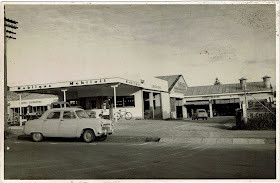During morning walks over Mount Maunganui, I sometimes imagine the little missionary schooner
Herald clearing the harbor entrance below, exactly 193 years ago. With a final tack and audible crack of its main sails, the vessel, according to missionary accounts, would first sail east, as far as Whakaari (White Island) before turning north for the Bay of Islands and home.
 |
The missionary schooner Herald, 1826-1828
Vintage Transport - Sailing Ships, New Zealand Post, 1975 |
The 55 ton
Herald was among the first sailing vessels to enter Tauranga Harbour. Built on the beach at Paihia in the Bay of Islands by the missionary leader Henry Williams and the merchant sea captain Gilbert Mair, the vessel was launched in January 1826. Henry Williams and the
Herald visited Tauranga on three occasions in June and December 1826 and again in 1828, with two objectives. The first was to spread the gospel among the resident Maori tribes. The second was to obtain pigs and potatoes for the
northern mission stations which were plagued by food shortages. As the intertribal Musket Wars escalated, Ngapuhi would only exchange their pigs, potatoes and other introduced crops for muskets and powder with the shipping at the Bay of Islands.
 |
The Anglican missionary leader and former Royal Navy Lieutenant Henry Williams
Lithograph, Charles Baugniet, C-0120-005 Alexander Turnbull Library, Wellington |
The missionary journals of Henry Williams and George Clarke reveal that their visit to Tauranga was a success. After anchoring in Pilot Bay, the missionaries and mixed crew of Maori and Pakeha, were well received by Ngai Te Rangi. For four nights they were fed, entertained and housed at Otamataha Pa (Te Papa), now the site of the mission cemetery.
Having noted the large quantities of potatoes and herds of pigs available, they returned by ship’s boat to Pilot Bay.
During three days of brisk trading, the
Herald was surrounded by up to 50 canoes and 700 Ngai Te Rangi, who competed to exchange their cargoes of potatoes, primarily for axes.
Why the missionaries were unable to obtain pigs is not made clear. During the excitement, George Clarke’s voice became hoarse from shouting and he became frustrated when Ngapuhi sailors aboard the Herald informed the local Maori traders that they were selling too cheaply. After loading the vessel with potatoes ‘as deep as she could swim,’ distributing fruit trees and vegetable seeds, and promising to establish a missionary in Tauranga when the intertribal wars abated, Henry Williams and Captain Gilbert Mair took the
Herald through the harbor entrance on the ebb tide of Thursday 29th June.
It is often claimed that the
Herald was first vessel to enter Tauranga Harbour. That honour or dishonour lies with one of the many small whaler-gun trading vessels out of Hobart and Sydney like the
Trial,
Caroline and
Brothers, that haunted the east coast between Cape Colville and East Cape from the 1810s. Additionally, Ngai Te Rangi visitors to the Bay of Islands in the winter of 1825 told Henry Williams that Pakeha vessels had already called to sell them muskets and how they had assisted ‘to hoist casks up out of the ships.'
Though it proved invaluable in spreading the gospel and ending missionary dependence on Ngapuhi for provisions, the
Herald had a short life. After also visiting Sydney and trading around New Zealand, it was wrecked at Hokianga in 1828. Though no lives were lost, when the passengers and crew were forced to swim ashore at 2 a.m. they and the
Herald were plundered, which, in accordance with traditional Maori salvage law, was
tika or the perfectly correct response.
Sources
Clarke, George, Journal, 19-29 June, 1826,
Journal of the Tauranga Historical Society, Vol 50, April 1974: 20-29.
Marsden, Samuel,
The Letters and Journals of Samuel Marsden,
1765- 1838, Elder, J. (ed.), Dunedin, Coulls, Somerville, Wilkie and Reid, Dunedin, 1932.
Williams, Henry.
The Early Journals of Henry Williams 1826-1840, Rogers, L. M. (comp.), Christchurch: Pegasus Press, 1961.








